

The Postwar Boom1945-1960 Part II |
 Down the Nile in my Maidenform Bra |
New ways of selling in the Postwar Boom
Motivational research- satisfying hidden desires- Ernest Dichter
Motivational research examined what made people make choices on the subconscious and unconscious levels and became popular in the 40s and 50s
"There were three main schools of motivational research or MR, but it was primarily an ad man named Ernest Dichter whose ideas gained widest circulation.
Dichter relied heavily on psychoanalytical interpretation drawn from consumers in "depth interviews" --and projective tests where thoughts and emotions were studied vs. recording a person's verbal response.
Depth interviews were free conversations pointed in the general direction of the problem and its components. The purpose was to learn what was on the individual's mind, to determine the feeling involved and to note anything that contradicted the expressed attitudes.
Freudian interpretations dominated Dichter's analyses.For example, he emphasized that the effects of early toilet training explain consumer responses to things as diverse as toothpaste and donations for community projects.
In 1946, after jobs with Chrysler, Procter & Gamble and an ad agency, Dichter founded the Institute of Motivational Research in New York. He defined MR as "qualitative research designed to uncover the consumer's subconscious or hidden motivations that determine purchase behavior."
MR "rooted the selling act within the human personality," meshing with a contemporary interest in Freudianism and the individual's inner life. Dichter's theory was predicated on non-rational consumer choice. Humans were perceived as immature, ruled by irrational insecurity and motivated by erotic desires.
MR pointed out the importance of egoistic and social needs as determinants of behavior."
motivational research reduced motives to sex and security-advertisers added "value" to make their products more appealing
source: http://www.moline-consulting.com/Reinventando/Pagines/conceptoDeLasMotivaciones.htm"Dichter’s case history is a fascinating mix of outlandish ideas and now-conventional solutions. To elevate typewriter sales, he suggested the machines be modelled on the female body, “making the keyboard more receptive, more concave”. People smoke, he explained, because it is both a sign of virility and a legitimate excuse to interrupt the day for a moment of pleasure, “comparable to sucking at the nipples of a gigantic world breast”. A phallic shape to lipstick increased sales by the way it offered a subconscious invitation to fellatio (“but one has to be careful not to go overboard and make the parallels too obvious,” Dichter cautioned)." (Source: Sex & Advertising: Retail Therapy, The Economist Dec 17, 2011)
Barbie, inventor Ruth Handler hired Dichter to market Barbie and it was he who advised her to make Barbie's Boobs Bigger.
Read about Barbie Why Does the Barbie Obsession Live On? in aricle by Elizabeth Eaves in Forbes Jan 30, 2009
|
An early Marlboro Man ad from 1955 features the slogan: "The filter doesn't get between you and the flavor!" read about how and why the macho symbol was adopted at http://www.npr.org/programs/ According to Ad Age |
Clairol- Does she or doesn't she? (at first feared too suggestive)
|
From 1949 to 1969, Maidenform launched one of the longest running campaigns a historically successful bra advertisement campaign entitled, “ I Dreamed.” It caused much controversy But why did the “I Dreamed” advertisements generate so much attention? What was the secret behind their success? What was the company really trying to sell American females? " Maidenform played on women's desires to be in the upper class by giving women the idea that they would be able to make their dreams come true if they wore the right type of bra" Ida Rosenthal marketed the first Up-lift bra. The I dreamed campaign was written by Mary Fillius from a NY ad agency read more at http://historywired.si.edu/object.cfm?ID=294
see more of the Maidenform at http://youtu.be/VgwDJ_JH15U read about Maidenform then and later campaigns see Dreaming of Bras |
 |
The Critics of Motivational Research
for some interesting reading on subliminal advertising click on CIA Subliminal (outside link) Presidential 2000 "RATS" ad (outside link)
Dr. Wilson Bryan Key in his book "The Clam-Plate Orgy and Other Subliminals the Media use to Manipulate Your Behavior" sees sex in more than the Ritz! |
In 1957 market researcher James M. Vicary unveiled a new secret weapon for advertisers that was sure to boost sales for markets around the world. Based on the theory of subliminal advertising, Vicary created the "invisible commercial" that he said would reach the audience "below the threshold of sensation or awareness" and prompt consumers to purchase the advertised product. Vicary tested this "invisible commercial" in a movie theatre where he showed a film interlarded with flashing, too-brief-to-be-seen Coca-Cola and popcorn messages. The messages were so rapid up to 1/3000 of a second that the audience could not detect them. According to Mr. Vicary, the messages increased popcorn sales by 57.5% and Coca-Cola sales by 18.1%. BUT IS IT TRUE? For every great idea, there are A Few Doubting Thomases. Psychologists Timothy Moore, Anthony Greenwald and Sean Draine have all individually reviewed evidence surrounding commercial subliminal marketing tactics and have come to similar conclusions. They have not found any evidence with any brands tested for a replicable perception effect, much less a lasting effect on behavior. "What about the James Vicary experiment in 1957?" you ask. Well, Vicary lied. When he was challenged to repeat the test, he could produce no significant increase in Coca-Cola or popcorn sales. Eventually he confessed that he had falsified the data from his first experiments. Does it ever work?
|
|
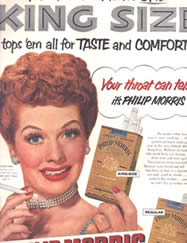 |
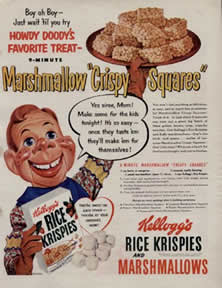 |
|
|
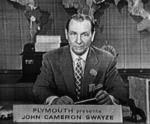 |
What was a commercial endorsement at the time?
1953 The TV Dinner Arrives |
 |
|
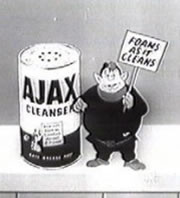 |
Sunday nights everything came to a stop while America watched The $64,000 Question (1955 - 1968). An immediate sensation with some of the highest ratings in television history and broadcast live in prime time, the show was a high pressure test of knowledge with fifty-five million watching on TV. Unlike today's quiz shows the questions were extremely difficult. NBC followed with Twenty One, a quiz show based on the game of blackjack. Twenty One made a pop phenomenon out of English Lecturer Charles Van Doren. At one time 22 game shows were on the air. In late 1958 disgruntled former contestants went public with accusations that the results were rigged and the contestants coached. The "winners" had been supplied answers in advance and the high-drama match-ups were carefully choreographed. Congressional hearings followed. Networks and sponsors acknowledged the public's distaste and kept game shows off the air for quite some time. The quiz show scandals made the networks forever leery of "single sponsorship" programming. Later they split advertising time in fifteen, thirty, and sixty-second increments and took control away from single sponsors and advertising agencies. In 1994 Robert Redford released his movie Quiz Show on the scandal. source: http://www.museum.tv/archives/etv/Q/htmlQ/quizshowsca/quizshowsca.htm http://www.pbs.org/wgbh/amex/quizshow/peopleevents/pande05.html |
|
Queen For A Day-- How weird could this be? See an episode here http://youtu.be/ZzyhpBkdtZ0 |
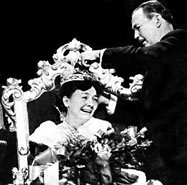 |
What's happening on the Radio?- Let's go Top 40! and target segments!
Rosser Reeves -The HARD Sell -USP (Unique Selling Proposition)
- Rosser Reeves work at Ted Bates New York emphasized science, research with a repetition of a single theme
- Work was a throwback to era when goal was to get attention not entertain
UNIQUE SELLING PROPOSITION- USP
"The consumer tends to remember just one thing from an advertisement-one strong claim, or one strong concept"
He didn't overestimate attention span or intelligence of audience; concept was buy this for this reason
selling point would be one that competition didn't and couldn't make
- Unique Selling Proposition (USP) examples; "Wonder bread helps build bones eight ways" "M&Ms melt in your mouth not in your hands" How do you spell relief? R-O-L-A-I-D-S"
- his ads often featured actors in white coats playing doctors; these eventually were reigned in by the Federal Trade Commission
- Reeves also used TV and his USP theories to successfully promote Dwight Eisenhower see inside link Rosser Reeves Selling the President
"Anacin, the pain reliever that doctors recommend most"
Leo Burnett- Inherent Drama
Leo Burnett of Chicago focused his pitch on the product not contests, premiums or sex
- his focus was information, good art, recipes and humour
- he looked for what made products stay in the market place- the" inherent drama" through warmth, shared emotions and experiences
- unlike Rosser he empathized with the audience using characters from folklore (archetypes) and jingles
- strong, simple, and instinctive imagery friendly ads. Jolly Green Giant, Charlie the Tuna, Morris the Cat, the Pillsbury Doughboy, Tony the Tiger, other Kellogg's cartoons and The Marlboro man were conceived at Leo Burnett.
- Burnett made the Jolly Green Giant more appealing by replacing his bearskin for a leafy suit, giving him a smile, and placing him in the friendly Valley of the Jolly Green Giant.
- Burnett chose the ideal macho stereotype cowboy to represent his Marlboro man
- History of Marlboro Man at http://www.npr.org/programs/morning/
features/patc/marlboroman/- See and hear some of Burnett's philosophy
1952
David Ogilvy -The Image and Science
- Ogilvy was a researcher turned writer who looked to Claude Hopkins scientific claim and Rubicam's image ideas
- he believed people would buy product not for product but what they associate with it- the brand image was all important
- he focused on high priced, high status products like Rolls Royce, Hathaway Shirts
- the Rolls Royce ad to the right ran in two newspapers and two magazines, yet was so widely known and admired that its headline -- "At Sixty Miles an Hour, the Loudest Noise in this New Rolls Royce Comes from the Electric Clock" -- now represents David Ogilvy in the Oxford Book of Quotations.
- Ogilvy immersed himself in Rolls-Royce data, which made up most of the body copy. The famous headline came from a specific, obscure piece of testing data from the factory illustrating his faith in research
- For Hathaway shirts he created the stylish man with a patch creating a man of mystery
Bill Bernbach - The New Advertising
- Bill Bernbach of Doyle, Dane Bernbach New York used a fresh style for second rank products and services turning being second into an advantage
- at most agencies copy came before art, but Bernbach had the artist and writer work together
- One of his clients was Ohrbach's, a low-priced department store competing against stores with large ad budgets. One of the Ohrbach's ads- a cat with a high-fashion hat and cigarette holder saying, "I found out about Joan," followed by text about a woman who had discovered the value of shopping at Ohrbach's. The ad became a pinup for copywriters.
- in the ad to the right copy reads "bring in your wife and just a few dollars ...and we will give you a new woman"
- http://adage.com/century/people001.html
- he also worked on the successful Volkswagen campaign- see the ads at
- read about the Ohrbach ads athttp://www.huffingtonpost.com/andrew-cracknell/mad-men-ads_b_1305136.html
Sources:
Silvulka, Juliann. Soap, Sex & Cigarettes. Belmont, CA:Wadsworth Publishing, 1998.
Reichert, Tom. The Erotic History of Advertising, New York: Prometheus Books , 2003.
Twitchell, James B. Adcult USA, New York:Columbia University Press, 1996.
Motivational Research http://www.moline-consulting.com/Reinventando/Pagines/conceptoDeLasMotivaciones.htm
Motivational Research http://www.aqr.org.uk/indepth/summer2003/page3.shtml
Sex & Advertising: Retail Therapy, The Economist Dec 17, 2011
Why Does the Barbie Obsession Live On? by Elizabeth Eaves in Forbes Jan 30, 2009
Cola Wars http://www.geocities.com/colacentury/ (former link)
see more ads and information on Lucy (Lucille Ball) and Smoking at http://smokingsides.com/asfs/B/Ball.html
History of I Love Lucy at http://www.museum.tv/archives/etv/I/htmlI/ilovelucy/ilovelucy.htm
I Love Lucy: Why America Loved Her and What She Meant to US http://honors.umd.edu/HONR269J/projects/chang.html
Lucille Ball- a Collection of ads she appears in http://www.lucilleball.net/collection/ads.html
Most Popular shows of 50s http://www.popculturemadness.com/Music/The-50s-TV.html
BeyondBooks Overview of TV in the 50s http://www.beyondbooks.com/ush12/6c.asp?pf=on
See Internet Archives Classic Commercials I http://www.archive.org/movies/details-db.php?collection=prelinger&collectionid=05865a
See Internet Archives Classic Commercials IIhttp://www.archive.org/movies/details-db.php?collection=prelinger&collectionid=05865b
See Internet Archives Classic Commercials III at http://www.archive.org/movies/details-db.php?collection=prelinger&collectionid=05865c
TVparty Icons of 60s http://www.tvparty.com/vaultcom2.html
Video Vault Cigarette Advertising on TV ( even the flntstones) http://www.tvparty.com/vaultcomcig.html
Watchmovies http://213.93.195.19/newlook/multimedia.cfm (an open source for film see old movies/cartoons/animations)
Quiz Show Scandals http://www.museum.tv/archives/etv/Q/htmlQ/quizshowsca/quizshowsca.htm
History of Television news http://www.museum.tv/archives/etv/N/htmlN/newsnetwork/newsnetwork.htm
hear a bio of Bill Bernbach at http://interface.audiovideoweb.com/lnk/ca25win25105/AAFAudio2/B_Bernbach_100k.wma/play.asx